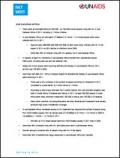What's New
Displaying results 3051 - 3060 of 4052
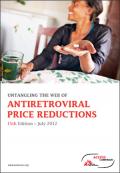
Resource | Publications,
Now is a critical time to ensure widest possible access to ART: a landmark scientific breakthrough in 2011 showed that treatment with antiretroviral medicines (ARVs) not only saves lives, but can also stop HIV from being transmitted by up to 96%. In response to this evidence, in 2012 the World Health Organization (WHO) issued guidance supporting immediate treatment – regardless of a person’s immune system’s status or CD4 count – for HIV-positive people who have HIV-negative partners, in order to help prevent transmission of the virus.5 At the same time, guidance was also issued suggesting the possibility of offering full antiretroviral therapy for life to all pregnant women living with HIV for prevention of mother-to-child transmission of the virus (PMTCT).

Resource | Presentations,
Presentation on Progress, Challenges and the Way Forward in ASEAN Member States at the ASEAN Multi-Sectoral Workshop on MDGs during July 30-31 2012 in Yangon, Myanmar
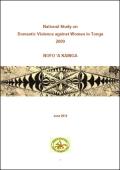
Resource | Publications,
Violence against women (VAW) is a global problem that crosses cultural, geographic, religious, social and economic boundaries and is a violation of human rights. Violence against women deprives women of their right to fully take part in social and economic life. It causes a myriad of physical and mental health issues and in some cases results in loss of life. A lack of understanding of the magnitude of VAW, its causes and consequences, and the trends and patterns across cultures and countries, including the Pacific, hinders the development of efforts to address it.
The National Study on Domestic Violence against Women in Tonga consisted of two separate components: a quantitative study based on the methodology developed for the WHO Multi-Country Study on Women’s Health and Domestic Violence against Women; and a qualitative study based on Tongan methodology of Talanoa and Nofo (see below). The use of qualitative and quantitative components was to seek results that complemented each other.
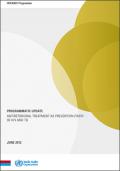
Resource | Publications,
In 2010, an estimated 34 million people were living with the human immunodeficiency virus (HIV), around 70% of them in sub-Saharan Africa. By the end of 2010, 6.6 million people, or 47% of those in need (CD4+ cell count <350 cells/mm3), were on antiretroviral therapy (ART), and an estimated 7.5 million people were still in need of treatment. While considerable progress has been made in extending ART coverage, there continue to be critical gaps. In the same year, coverage for children was reported to be less than 23%, there were 2.7 million new infections and more than 20 million people were not yet treatment-eligible (as most of them did not know their HIV status). There were an estimated 1.1 million new cases of HIV-associated tuberculosis (TB), which led to 24% of HIV-related deaths. HIV is the strongest risk factor for developing TB, and people living with HIV have a 20–37 times higher risk of developing TB than those who do not. ART has a significant secondary prevention benefit for both HIV and TB, and expanded access to ART has probably averted millions of HIV infections and cases of TB.
The World Health Organization (WHO) has introduced the concept of HIV elimination through the use of combination prevention and prevention of mother-to-child transmission (PMTCT) of HIV. Additionally, WHO and the Joint United Nations Programme on HIV/AIDS (UNAIDS) launched Treatment 2.0 to look at ways to provide better services to a larger number of persons at lesser cost, and in a way that helps to retain them on lifelong ART. This would also greatly benefit HIV prevention efforts.
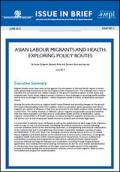
Resource | Publications,
Migrant health issues have risen on the agenda of policymakers in the Asia-Pacific region in recent years, generating momentum at the very highest levels of government. The challenge now is how to translate this momentum into visible changes on the ground. Despite progress on both policy and programmatic fronts, Asian migrant workers continue to face challenges in accessing health facilities and services at all stages of migration – before departure, while in transit, at destination and upon return.
Moving the policy discourse on migrant health issues forward and ensuring changes on the ground first require disentangling myths from realities. There is a persistent public perception that labour migrants are carriers of diseases or that they are a burden to the health systems of the countries that receive them. The reality, however, is different. Labour migrants are generally young and healthier than the native population and they tend to under-utilize health services at destination. Labour migrants’ vulnerability to ill health, however, increases during the migration process due to various risk factors such as lack of adequate health insurance, poverty and uncertain legal status.

Resource | Presentations,
The road to zero new infections among people who inject drugs in Asia. Draft for Discussion at Meeting of UN Regional Interagency Team on AIDS (UN RITA) 14 June 2012, Bangkok, Thailand
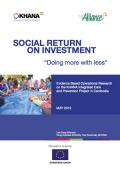
Resource | Publications,
The Social Return on Investment(SROI) method is a form of cost benefit analysis to monetize project outcomes. It has been adapted and simplified for the community level with the incorporation of social, health, environmental and economic costs and benefits enabling the calculation of a ratio of cost to benefit. This is an appropriate approach, in line with the current donors’ growing emphasis on cost efficiency and effectiveness and the Paris declaration on aid effectiveness - demonstrating value for money, “doing more with less”.
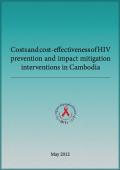
Resource | Publications,
This report is aimed at assisting in building the case for the need for significant improvements across prevention and impact mitigation interventions leading to a “value for money”, cost-effective national response. Each of the main sections in this report are focused on key affected populations—Entertainment Workers (EW) who sell sex, men who have sex with men (MSM) and transgender people (TG) and injecting drug users (IDUs). Each population section goes through the assumptions and results of both the costing and cost-effectiveness analyses for each group.






